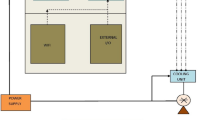Abstract
A hybrid silicon wafer-scale multi-chip packaging design was chosen as the basis for a high performance, high power dissipation vehicle suitable for VLSI/ULSI applications. The package supports 25 chips (l x l cm), each capable of dissipating as much as 40 W. The heat generated by the chips is removed by water channels in the underlying structure. Deep- (about 1000 μm), and shallow- (about 100 μm. deep), channel designs, with a water flow rate of 499 cc/sec, and 39 cc/sec, respectively, have been analyzed. Both designs are capable of keeping circuit temperature rise small, while maintaining a uniform chip temperature. The temperature distribution of the thermal module was obtained by solving the 2-D heat conduction equation for isolated heat sources (the chips), and heat sinks (the water channels). Assuming that each of the 25 chips dissipates 40 W/cm2, and heat is removed only via water flow, the maximum chip tempertaure(t cc which occurs at the center of a chip) rise relative to inlet water temperature is 11.4° C, and 19.0° C for the deep, and shallow designs, respectively. The maximumt cc variation between chips on the module (the same as the water temperature rise), for the cases analyzed, is 0.5° C for the deep-channel design, and 6° C for the shallow-channel design (calculated at 25° C inlet water temperature, and an optimum flow rate). For the extremely-uneven powered case (all chips except one at the inlet end are powered at 40 W/chip), the maximum temperature increases between inlet water temperature and chip temperature,t cc , remain relatively the same, but the maximumt cc variations between chips on the module increase to 11.4° C, and 19° C for the deep, and shallow designs, respectively, as might be expected. The temperature variation on a powered chip is less than 3° C for both the deep- and shallow-channel designs.
Similar content being viewed by others
References
R. H. Dennard, F. H. Gaensslen, H.-N. Yu, V. L. Rideout, E. Bassous, and A. R. LeBlanc, IEEE J. Solid-State CircuitsSC-9, 256 (1974).
A. Reisman, Proc. IEEE71, 550, (1983).
A. J. Blodgett, Sci. Am., July 1983.
A. Reisman, M. Berkenblit, C. J. Merz, and A. K. Ray, J. Electron. Mater.11, 391, (1982).
D. B. Tuckerman and R. F. W. Pease, IEEE Electron Devices Lett.EDL-2, 126, (1981).
D. B. Tuckerman, Ph.D. Dissertation, Stanford University (1984).
M. Mahalingam, Proc. IEEE73, 1396, (1985).
T. Kishimoto, Proc. Elect. Components Conf. 595, (1986).
A. J. Blodgett and D. R. Barbour, IBM J. Res. Develop.26, 30, (1982).
R. C. Chu, V. P. Hwang, and R. E. Simons,ibid. 45, (1982).
H. S. Carslaw and J. C. Jaeger, Conduction of Heat in Solids, 2nd ed., (Oxford University Press, 1959).
B. Gebhart, Heat Transfer, 2nd ed., (McGraw-Hill, New York, 1971) pp. 48–52.
Engineering Property Data on Selected Ceramics, Vol. 2, Carbides, Metals and Ceramics Information Center, 505 King Avenue, Columbus, Ohio 43201, 1979.
Silicon Carbide Substrates, Data sheet from Standard Oil Engineered Materials Company, P.O. Box 156, Niagara Falls, New York 14302, 1986.
K. E. Petersen, Proc. IEEE70, 420 (1982).
T. Baumeister, Mark’s Standard Handbook for Mechanical Engineers, 8th ed., (McGraw-Hill, 1978) pp. 5-52–5-53.
W. Griffel, Plate Formulas, (Frederick Ungar Publishing Co., New York, 1968).
E. P. Popov, Mechanics of Materials, 2nd ed., (Prentice-Hall, Englewood Cliffs, New Jersey, 1976), pp. 48–52.
R. K. Shah, and A. L. London, Laminar Flow Forced Convection in Ducts, (Academic Press, 1978).
B. S. Petukhov, in Advances in Heat Transfer, Vol. 6, (Academic Press, 1970), p. 523.
Fox and McDonald, Introduction to Fluid Mechanics, 3rd ed., (Wiley, New York, 1985) p. 362.
Cabe and Smith, Unit Operations of Chemical Engineering, (McGraw-Hill, New York, 1956), p. 159.
H. Schlichting, Boundary-Layer Theory, 6th ed., (McGrawHill, New York, 1968), p. 567.
D. Nayak, L. Hwang, I. Turlik, and A. Reisman, J. Electron. Mater. (to be published).
J. J. Dongarra, C. B. Moler, J. R. Bunch, and G. W. Stewart, Linpack Users’ Guide, (Siam, Philadelphia, 1979).
R. C. Weast, CRC Handbook of Chemistry and Physics, 66th ed., (CRC Press, Boca Raton, Florida, 1985).
Author information
Authors and Affiliations
Rights and permissions
About this article
Cite this article
Hwang, LT., Turlik, I. & Reisman, A. A thermal module design for advanced packaging. J. Electron. Mater. 16, 347–355 (1987). https://doi.org/10.1007/BF02657910
Received:
Issue Date:
DOI: https://doi.org/10.1007/BF02657910




